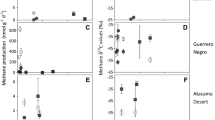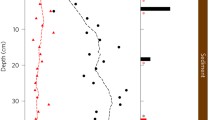Abstract
Rates and pathways of methane production were determined from photosynthetic soft microbial mats and gypsum-encrusted endoevaporites collected in hypersaline environments from California, Mexico and Chile, as well as an organic-rich mud from a pond in the El Tatio volcanic fields, Chile. Samples (mud, soft mats and endoevaporites) were incubated anaerobically with deoxygenated site water, and the increase in methane concentration through time in the headspaces of the incubation vials was used to determine methane production rates. To ascertain the substrates used by the methanogens, 13C-labeled methylamines, methanol, dimethylsulfide, acetate or bicarbonate were added to the incubations (one substrate per vial) and the stable isotopic composition of the resulting methane was measured. The vials amended with 13C-labeled methylamines produced the most 13C-enriched methane, generally followed by the 13C-labeled methanol-amended vials. The stable isotope data and the methane production rates were used to determine first order rate constants for each of the substrates at each of the sites. Estimates of individual substrate use revealed that the methylamines produced 55–92 % of the methane generated, while methanol was responsible for another 8–40 %.







Similar content being viewed by others
References
Aicher A, Mincer TJ (2014) Volatile organic molecule production by cyanobacteria and eukaryotic phytoplankton. Paper presented at the American Society of Microbiology meeting, Boston, 17–20 May 2014
Beaudoin CS (2015) Use of stable carbon isotopes to assess anaerobic and aerobic methane oxidation in hypersaline ponds. MS thesis, University of Missouri
Bebout BM, Hoehler TM, Thamdrup B, Albert D, Carpenter SP, Hogan M, Turk K, Des Marais DJ (2004) Methane production by microbial mats under low sulphate concentrations. Geobiol 2:87–96
Bernard BB, Brooks JM, Sackett WM (1976) Natural gas seepage in the Gulf of Mexico. Earth Planet Sci Lett 31:48–54
Blair NE, Carter WD Jr (1992) The carbon isotope biogeochemistry of acetate from a methanogenic marine sediment. Geochim Cosmochim Acta 56:1247–1258
Conrad R (2005) Quantification of methanogenic pathways using stable carbon isotopic signatures: a review and a proposal. Org Geochem 36:739–752
Conrad R, Claus P (2005) Contribution of methanol to the production of methane and its 13C-isotopic signature in anoxic rice field soil. Biogeochemistry 73:381–393
Crill PM, Martens CS (1986) Methane production from bicarbonate and acetate in an anoxic marine sediment. Geochim Cosmochim Acta 50:2089–2097
Demergasso C, Chong G, Galleguillos P, Escudero L, Martínez-Alonso M, Esteve I (2003) Tapetes microbianos del Salar de Llamará, norte de Chile. Revista Chilena de Historia Natural 76:485–499
Des Marais DJ, Cohen Y, Nguyen H, Cheatham M, Cheatham T, Munoz E (1989) Carbon isotopic trends in the hypersaline ponds and microbial mats at Guerrero Negro, Baja California Sur, Mexico: implications for Precambrian stromatolites. In: Cohen Y, Rosenberg E (eds) Microbial mats: physiological ecology of benthic microbial communities. American Society for Microbiology, Washington DC, pp 191–203
Dorador C, Meneses D, Urtuvia V, Demergasso C, Vila I, Witzel K-P, Imhof JF (2009) Diversity of Bacteroidetes in high-altitude saline evaporitic basins in northern Chile. J Geophys Res. doi:10.1029/2008JG00837
García-Maldonado JQ, Bebout BM, Celis LB, López-Cortés A (2012) Phylogenetic diversity of methyl-coemzyme M reductase (mcrA) gene and methanogenesis from trimethylamine in hypersaline environments. Int Microbiol 15:33–41
Jiang N, Wang Y, Dong X (2010) Methanol as the primary methanogenic and acetogenic precursor in the cold Zoige wetland at Tibetan Plateau. Microb Ecol 60:206–213
Kelley CA, Prufert-Bebout LE, Bebout BM (2006) Changes in carbon cycling ascertained by stable isotopic analyses in a hypersaline microbial mat. J Geophys Res 111:G04012. doi:10.1029/2006JG000212
Kelley CA, Poole JA, Tazaz AM, Chanton JP, Bebout BM (2012) Substrate limitation for methanogenesis in hypersaline environments. Astrobiology 12:89–97
Kelley CA, Nicholson BE, Beaudoin CS, Detweiler AM, Bebout BM (2014) Trimethylamine and organic matter additions reverse substrate limitation effects on the δ13C values of methane produced in hypersaline microbial mats. Appl Environ Microbiol 80:7316–7323
King GM (1984) Utilization of hydrogen, acetate and “noncompetitive” substrates by methanogenic bacteria in marine sediments. Geomicrobiol J 3:275–306
King GM (1991) Measurement of acetate concentrations in marine pore waters by using an enzymatic approach. Appl Environ Microbiol 57:3476–3481
King GM, Klug MJ, Lovley DR (1983) Metabolism of acetate, methanol, and methylated amines in intertidal sediments of Lowes Cove, Maine. Appl Environ Microbiol 45:1848–1853
Krzycki JA, Kenealy WR, DeNiro MJ, Zeikus JG (1987) Stable carbon isotope fractionation by Methanosarcina barkeri during methanogenesis from acetate, methanol, or carbon dioxide-hydrogen. Appl Environ Microbiol 53:2597–2599
Lazar CS, Parkes RJ, Cragg BA, L’Haridon S, Toffin L (2011) Methanogenic diversity and activity in hypersaline sediments of the centre of the Napoli mud volcano, Eastern Mediterranean Sea. Environ Microbiol 13:2078–2091
Lomans BP, Op den Camp HJM, Pol A, van der Drift C, Vogels GD (1999) Role of methanogens and other bacteria in degradation of dimethyl sulfide and methanethiol in anoxic freshwater sediments. Appl Environ Microbiol 65:2116–2121
Londry KL, Dawson KG, Grover HD, Summons RE, Bradley AS (2008) Stable carbon isotope fractionation between substrates and products of Methanosarcina barkeri. Org Geochem 39:608–621
Lovley DR, Klug MJ (1983) Methanogenesis from methanol and methylamines and acetogenesis from hydrogen and carbon dioxide in the sediments of a eutrophic lake. Appl Environ Microbiol 45:1310–1315
McEwen AS, Ojha L, Dundas CM, Mattson SS, Byrne S, Wray JJ, Cull SC, Murchie SL, Thomas N, Gulick VC (2011) Seasonal flows on warm Martian slopes. Science 333:740–743
McKay CP, Friedmann EI, Gomez-Silva B, Caceres-Villanueva L, Andersen D, Landheim R (2003) Temperature and moisture conditions for life in the extreme arid region of the Atacama Desert: four years of observations including the El Niño of 1997–1998. Astrobiol 3:393–406
Mincer TJ, Aicher AC (2013) Production of methanol by a wide phylogenetic array of phytoplankton and implications for epibiont interactions. Paper presented at the ASLO aquatic sciences meeting, New Orleans, 17–22 Feb 2013
Oremland RS, Polcin S (1982) Methanogenesis and sulfate reduction: competitive and noncompetitive substrates in estuarine sediments. Appl Environ Microbiol 44:1270–1276
Oremland RS, Marsh LM, Polcin S (1982) Methane production and simultaneous sulphate reduction in anoxic, salt marsh sediments. Nature 296:143–145
Oren A, Elevi Bardavid R, Kandel N, Aizenshtat Z, Jehlicˇka J (2013) Glycine betaine is the main organic osmotic solute in a stratified microbial community in a hypersaline evaporitic gypsum crust. Extremophiles 17:445–451
Osterloo MM, Hamilton VE, Banfield JL, Glotch TD, Baldridge AM, Christensen PR, Tornabene LL, Anderson FS (2008) Chloride-bearing materials in the southern highlands of Mars. Science 319:1651–1654
Parnell J, Cullen D, Sims MR, Bowden S, Cockell CS, Court R, Ehrenfreund P, Gaubert F, Grant W, Parro V, Rohmer M, Sephton M, Stan-Lotter H, Steele A, Toporski J, Vago J (2007) Searching for life on Mars: selection of molecular targets for ESA’s Aurora ExoMars mission. Astrobiology 7:578–604
Potter EG, Bebout BM, Kelley CA (2009) Isotopic composition of methane and inferred methanogenic substrates along a salinity gradient in a hypersaline microbial mat system. Astrobiology 9:383–390
Reeburgh WS (2007) Oceanic methane biogeochemistry. Chem Rev 107:486–513
Rice AL, Gotoh AA, Ajie HO, Tyler SC (2001) High precision continuous-flow measurements of δ13C and δD of atmospheric CH4. Anal Chem 73:4104–4110
Schink B, Zeikus JG (1982) Microbial ecology of pectin decomposition in anoxic lake sediments. J Gen Microbiol 128:393–404
Sørensen J, Glob E (1987) Influence of benthic fauna on trimethylamine concentrations in coastal marine sediments. Mar Ecol Prog Ser 39:15–21
Sørensen K, Rˇeháková K, Zapomeˇlová E, Oren A (2009) Distribution of benthic phototrophs, sulfate reducers, and methanogens in two adjacent saltern evaporation ponds in Eilat, Israel. Aquat Microb Ecol 56:275–284
Stets EG, Hines ME, Kiene RP (2004) Thiol methylation potential in anoxic, low-pH wetland sediments and its relationship with dimethylsulfide production and organic carbon cycling. FEMS Microbiol Ecol 47:1–11
Summons RE, Franzmann PD, Nichols PD (1998) Carbon isotopic fractionation associated with methylotrophic methanogenesis. Org Geochem 28:465–475
Tassi F, Aguilera F, Darrah T, Vasilli O, Capaccioni B, Poreda RJ, Huertas AD (2010) Fluid geochemistry of hydrothermal systems in the Arica-Parinacota, Tarapacá and Antofagasta regions (northern Chile). J Volcanol Geotherm Res 192:1–10
Tazaz AM, Bebout BM, Kelley CA, Poole J, Chanton JP (2013) Redefining the isotopic boundaries of biogenic methane: methane from endoevaporites. Icarus 224:268–275
Waldron PJ, Petsch ST, Martini AM, Nüslein K (2007) Salinity constraints on subsurface archaeal diversity and methanogenesis in sedimentary rock rich in organic matter. Appl Environ Microbiol 73:4171–4179
Whiticar MJ (1999) Carbon and hydrogen isotope systematics of bacterial formation and oxidation of methane. Chem Geol 161:291–314
Zhang G, Jiang N, Liu X, Dong X (2008) Methanogenesis from methanol at low temperatures by a novel psychrophilic methanogen, “Methanolobus psychrophilus” sp. nov., prevalent in Zoige wetland of the Tibetan Plateau. Appl Environ Microbiol 74:6114–6120
Acknowledgments
Funding by the NASA Exobiology program is gratefully acknowledged. We would also like to thank Angela Detweiler, Adrienne Frisbee, Amanda Tazaz, Tyler Mauney, Jennifer Poole, Brooke Nicholson, Claire Beaudoin, and Alfonso Davila, as well as our many colleagues in Mexico and Chile, for help in the field and laboratory. We are also appreciative of the access to the field sites provided by Exportadora de Sal, S.A. de C.V and the U.S. Fish and Wildlife Service. Neal Blair is thanked for his thoughtful comments on an earlier version of the manuscript.
Author information
Authors and Affiliations
Corresponding author
Additional information
Responsible Editor: Mark Brush.
Rights and permissions
About this article
Cite this article
Kelley, C.A., Chanton, J.P. & Bebout, B.M. Rates and pathways of methanogenesis in hypersaline environments as determined by 13C-labeling. Biogeochemistry 126, 329–341 (2015). https://doi.org/10.1007/s10533-015-0161-9
Received:
Accepted:
Published:
Issue Date:
DOI: https://doi.org/10.1007/s10533-015-0161-9




